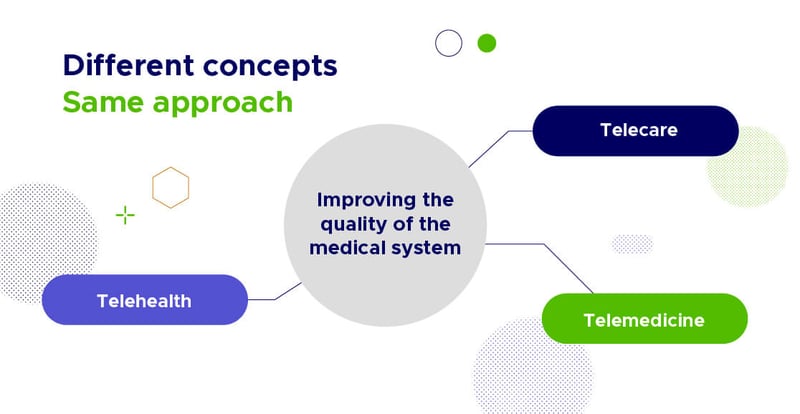Telemedicine has made a difference in patients and health professionals since it began. Nowadays, it aims to revolutionise the medical system putting the patient experience at the centre of it.
The concept and exercise of telemedicine are not new. This procedure was supposed to grow in the next ten years. However, no one expected the Covid-19 pandemic to hit and, consequently, boost services that were recently beginning to be part of people’s daily lives.
To understand how crucial telemedicine can be is necessary to know what it stands for. Telemedicine provides healthcare services through digital platforms that allow the health professional and the patient to connect despite not being in the same location. It also involves a secure transmission of medical data and information through text, sound, images and/or other forms needed for patient prevention, diagnosis, treatment, and follow-up.
The digitalisation of the healthcare sector and the development of this service in the last two years has positively impacted people’s lives.
As a consequence of Covid-19, in Europe, there is a notorious decrease in the number of health professionals while the number of patients keeps rising. So, it is vital to count on a system that is patient-centred and provides patients and doctors with a safe space to exchange information, know the patient’s needs and history, and consult with other medical specialists if needed.
In the case of the United Kingdom, the alternative of telemedicine has been present since 1991 and has grown in all the regions since then. Consequently, given the pandemic and technological advances, approximately 78% of the British population agreed that telemedicine is an even better alternative to an in-person consultation.
Another research showed that 88% of the consultants felt that greater use of remote care should be retained in the longer-term in Great Britain since they feel this type of medical encounter leads to a more effective course of action.

The difference between telehealth, telemedicine, and telecare
Since the concept and practice of remote health care have grown significantly, and there can be confusion among words and terminologies that are similar but are not the same.
Telehealth refers to a technological system that facilitates the doctor-patient relationship and covers non-clinical services. Therefore, telehealth also addresses alternative and complementary services such as training, patient education and support, and administration of specific medical methods. It’s an alternative that helps the patient to book the call with the health professional, follow-up next steps of the visit, and access to in-home care if needed.
On the other hand, telemedicine is the delivery of healthcare services over a distance using communication technology. Most of the time, it is supported by a software solution that combines all the technology needed to help healthcare providers treat patients and diagnose them remotely. This method is mostly used, for example, when making a follow-up on the patient’s health issue or when traveling to share its concerns with a doctor about some possible health issue.
Telecare supports the patient from a distance, thanks to a technology system. Given its development, it can collect relevant data from the patient and minimise risks. This connection can prevent the patient from suffering unexpected outcomes and facilitates immediate medical attention when needed. This is done, for example, by intelligent electronic devices that collect relevant medical data.
As shown, the words may sound the same, but the concept varies. All these services are focused on improving the quality of the medical system. However, telemedicine software holds benefits for patients, doctors, and businesses. These aim to offer a better life and professional experience, easy access and understanding of the platforms and reduce costs without compromising revenues.
Telemedicine, the improvement of healthcare delivery
Providing a patient-centred experience is as critical as counting on a system that’s easy to understand for both: the patient and health professional. Having a tool that allows each person to manage their time freely by booking a consultation when they are available, that enables them with a safe space and a professional to trust their information to, and that reduces the costs of the consultation itself, are some of the benefits that telemedicine brings to the table.
Telemedicine is perceived as an effective alternative to traditional face-to-face medical care. This new technology is changing the healthcare market and improving patients' medical experience. The digitalisation and evolution of a system that used to be effective only when it was an in-person consultation enable teleconsultations, telemonitoring, and telediagnostics.
These e-health alternatives are just the first steps to a healthcare system that aims to make the patients’ well-being and safety the centre of the medical experience.
The pandemic brought many worldwide changes and challenges to overcome. Still, thanks to the evolution of technology, more people can access a consultation without interrupting their daily lives. At the same time, more professionals can connect with others to discuss medical concerns and opportunities.
Telemedicine has empowered the relationship between patients and health professionals, allowing them to communicate with different experts from their own countries or other parts of the world. It is a digital system that’s growing and making it easier for people to have control over their health.
ACF Technologies aims to provide a digital service that improves e-health delivery in hospitals, clinics, health centres, and patients’ homes. In ACF, telemedicine is just the beginning of a chain of services that aim to operate in an effortless, efficient, and pleasant way putting the patients and medical care first. Digital solutions are achievable in the medical field, and in ACF we show you how.




